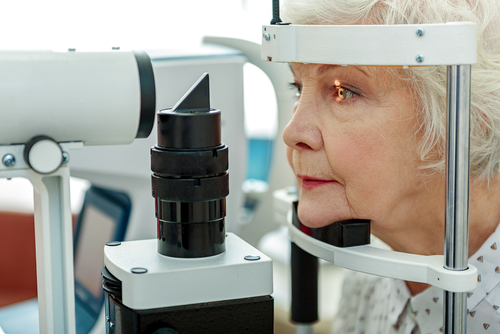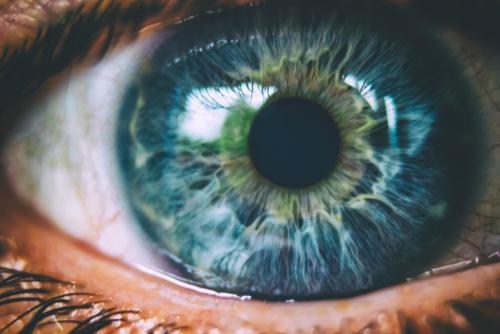What is Glaucoma?
Many people affected with glaucoma do not experience any symptoms and may not be aware that they have the disease until they have lost a significant amount of vision. With early detection and treatment, the risk of serious loss of vision or blindness is greatly reduced. Catching glaucoma at an early, treatable stage is one important reason to have thorough eye examinations regularly.1
Risk Factors for Glaucoma
There are several factors that increase the risk of developing glaucoma, including age and ethnicity. Statistics show that individuals over the age of 60 and of African or Asian descent have a higher likelihood of developing glaucoma, as do individuals with the following risk factors:

- Having other family members with glaucoma
- Having elevated intraocular pressure
- Having poor vision or other eye disorders or injuries
- Having certain medical conditions, such as diabetes
- Taking certain medications, such as corticosteroids for prolonged periods
Patients with risk factors for glaucoma should be especially vigilant about having regular eye examinations.
Causes of Glaucoma
Certain diseases or conditions can contribute to the development of glaucoma. These include:
- Increased pressure within the eye
- Severe eye infection
- Injury to the eye
- Blocked blood vessels
- Inflammatory conditions of the eye
- Glaucoma is considered primary if its origin is unknown and secondary if it results from another medical condition.
- Pseudoexfoliation Glaucoma

Types of Glaucoma
There are several types of glaucoma. The two major types are primary open-angle glaucoma, in which fluid drains too slowly from the drainage channels (trabecula) of the eye, and angle-closure (narrow-angle) glaucoma, which occurs when the trabeculae become blocked.
Open-Angle Glaucoma
Open-angle glaucoma is by far the most common form of glaucoma, accounting for up to 95% of cases and impacting roughly 4 million Americans. This form of glaucoma is a result of poor fluid outflow from the eye, leading to fluid accumulation, increased pressure in the eye, and eventually, damage to the optic nerve.
As with all forms of glaucoma, symptoms of open-angle glaucoma are gradual and often unnoticeable in early stages. Many patients don’t notice open-angle glaucoma symptoms until the disease has progressed considerably. Regular eye exams are key to early diagnosis, treatment, and vision preservation.2
Angle-Closure Glaucoma
Angle-closure glaucoma, also known as acute angle or narrow-angle glaucoma is less common than open-angle glaucoma. This form of the condition is also a result of blocked drainage canals that lead to a rapid rise in intraocular pressure. Unlike open-angle glaucoma, angle-closure glaucoma develops very quickly and has very noticeable symptoms.
Angle-closure glaucoma is 4 times more common in women than in men and is most likely to affect individuals over the age of 60. Untreated, angle-closure glaucoma can lead to blindness.3
Other types of glaucoma, which occur much more rarely, include:
- Low Tension Glaucoma
- Congenital Glaucoma
- Secondary Glaucoma
- Pigmentary Glaucoma

Symptoms of Glaucoma
It is important to remember that patients with early stage glaucoma are most often asymptomatic. When symptoms occur, they vary depending on the type of glaucoma and can occur in one eye or both eyes.
The symptoms of open-angle glaucoma include:
- Dim or blurred vision
- Gradual loss of peripheral vision
- Tunnel vision (at advanced stages)
The symptoms of angle-closure glaucoma encompass systemic as well as eye symptoms, including:
- Severe eye pain
- Nausea and vomiting
- Sudden visual disturbance
- Blurred vision
- Halos around lights
- Red eyes
- Headache
Either type of glaucoma may be a primary or secondary disorder.
Diagnosis of Glaucoma
The diagnosis of glaucoma is made after a comprehensive medical examination of the eye and a review of the patient’s medical history. Tests are conducted to confirm the diagnosis. Testing may include some of the following:
- Tonometry
- Dilated eye examination
- Visual field test (perimetry)
- Retinal evaluation
- Optic nerve evaluation
- Pachymetry
- Gonioscopy
- Visual acuity test

Once glaucoma has been diagnosed, treatment should begin as soon as possible to help minimize the risk of permanent vision loss.
Treatment of Glaucoma
There is no cure for glaucoma, so treatment focuses on relieving symptoms and preventing further damage and vision loss. Treatment may include medication, laser surgery, or other forms of eye surgery designed to drain excess fluid and alleviate pressure on the eye.
Learn More About Glaucoma Treatment
Glaucoma Treatment in Cincinnati and Northern Kentucky
At Cincinnati Eye Institute, our doctors are highly experienced in the diagnosis and treatment of glaucoma. As with many conditions, early diagnosis of glaucoma is key and is made possible through regular eye examinations that help our doctors detect this condition often before symptoms are present.
Schedule an Appointment
With convenient locations throughout Ohio and Northern Kentucky, we make it easy to access superior eye care for yourself and your family. To schedule your eye examination or to learn more about glaucoma treatment options, please contact us.
1 American Academy of Ophthalmology. What is Glaucoma? Available: https://www.aao.org/eye-health/diseases/what-is-glaucoma. Accessed September 30, 2020.
2 Glaucoma Research Foundation. Symptoms of Open-Angle Glaucoma. Available: https://www.glaucoma.org/glaucoma/symptoms-of-primary-open-angle-glaucoma.php. Accessed September 30, 2020.
3 Mayo Clinic. Glaucoma. Available: https://www.mayoclinic.org/diseases-conditions/glaucoma/symptoms-causes/syc-20372839. Accessed September 30, 2020.
